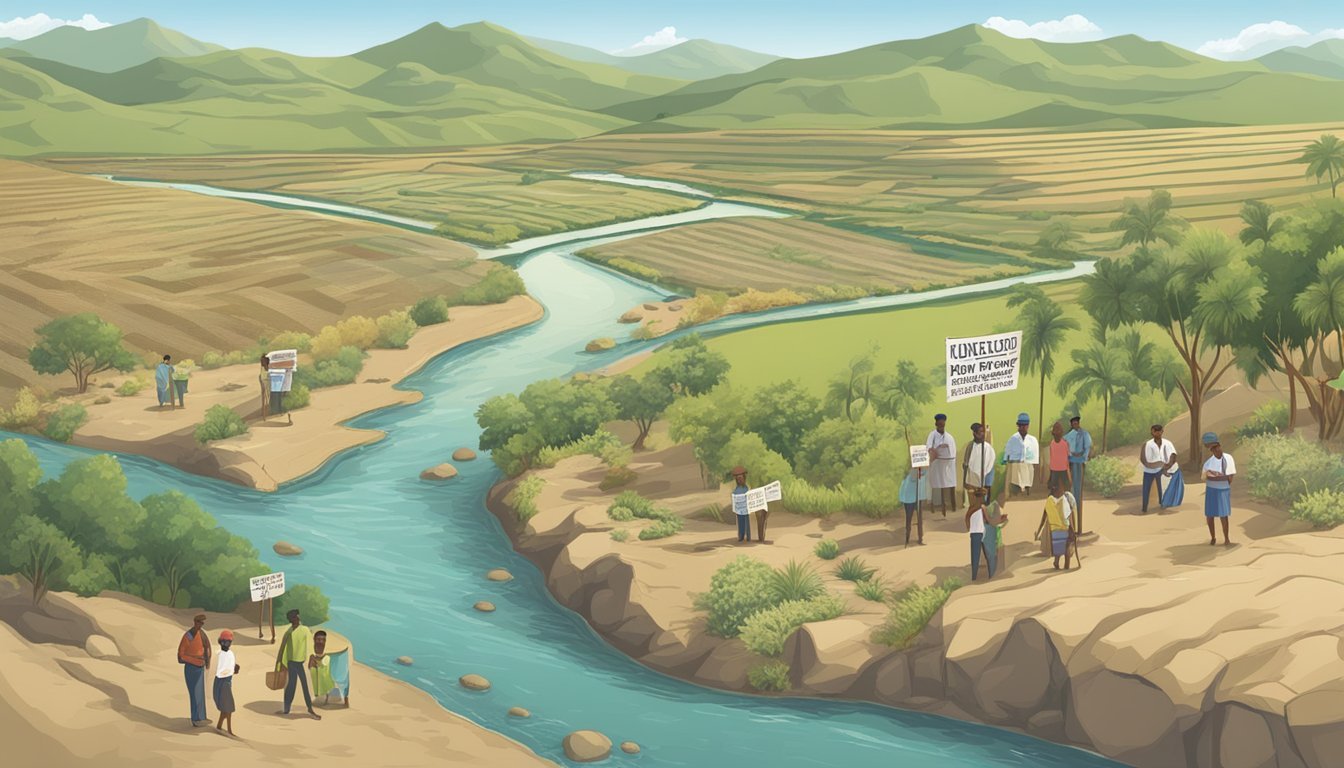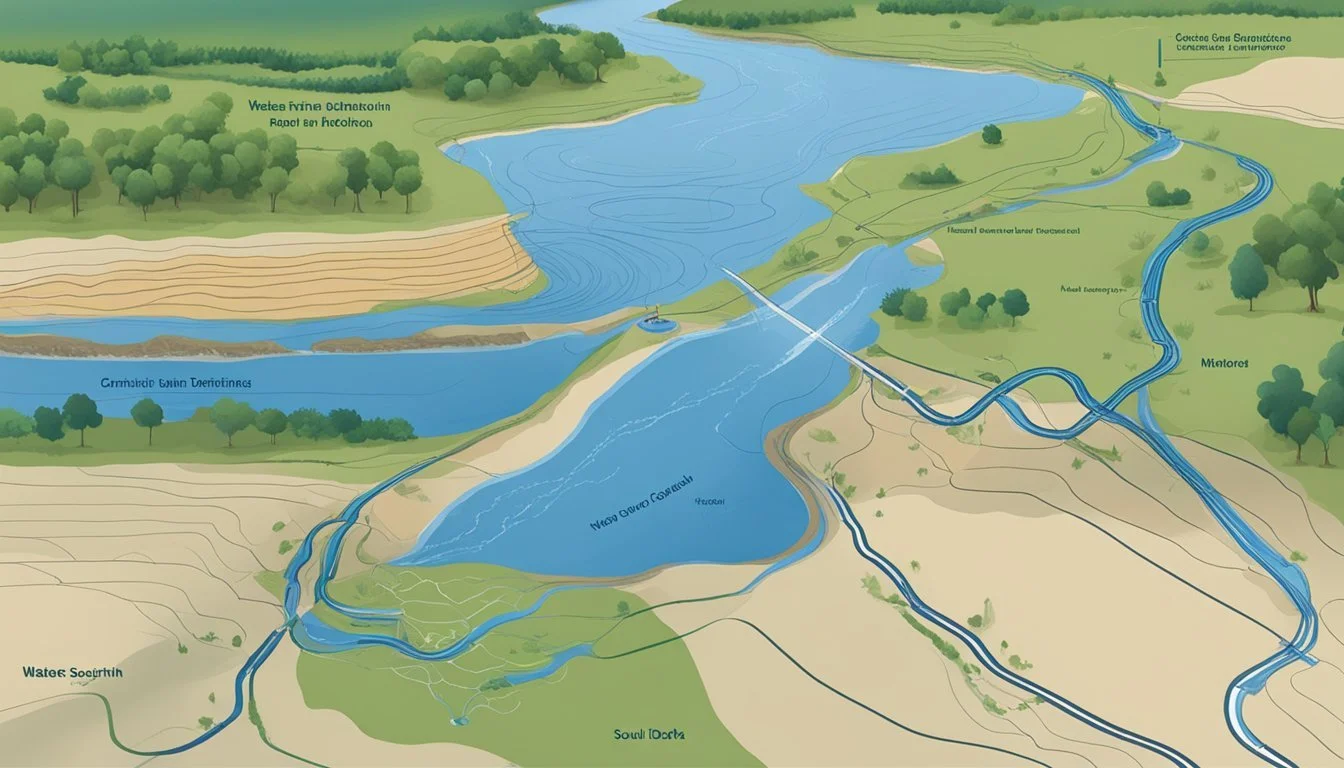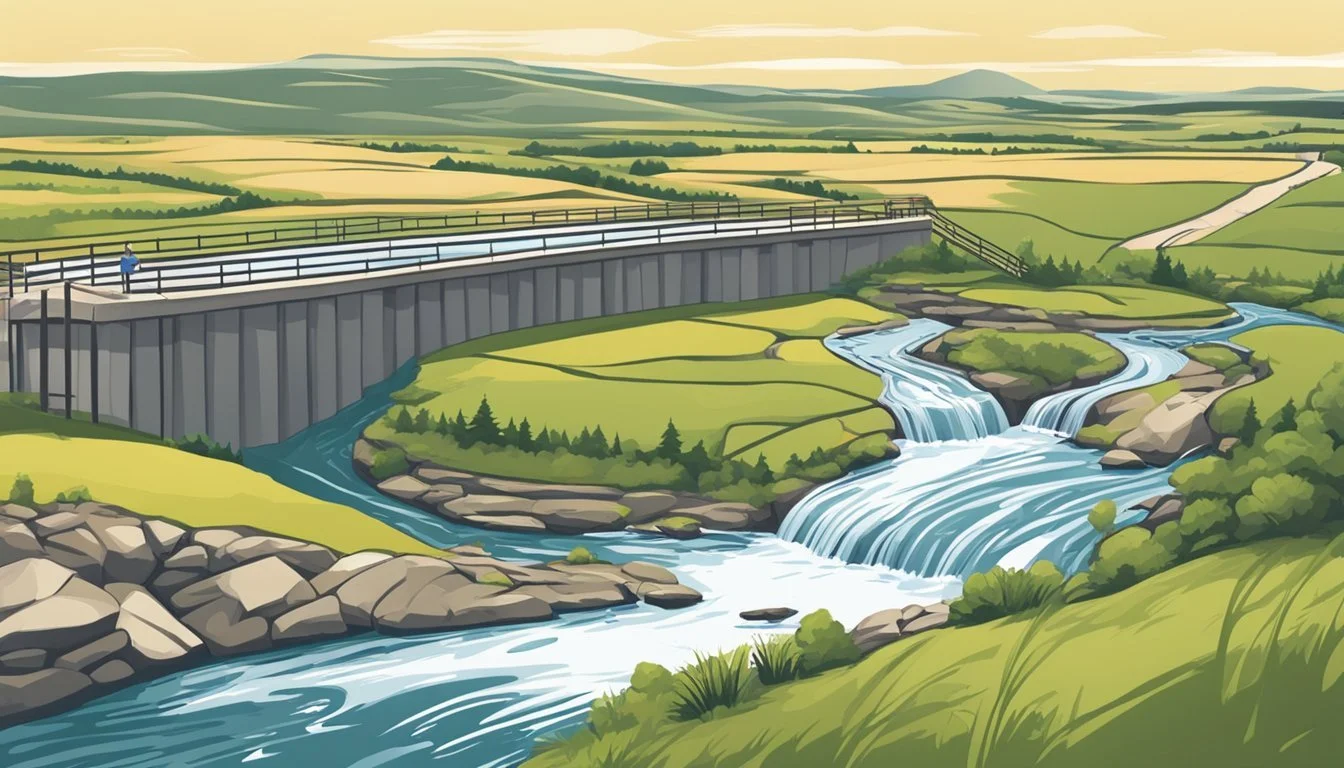Water Rights in South Dakota
Navigating Legal and Environmental Challenges
In South Dakota, water rights govern the utilization of one of the state's most precious resources. All water within the state is considered property of the public, and the use of this water is contingent upon securing a water right. This legal framework is in place for all forms of water use, with the exception of purposes deemed domestic. The state's approach to managing water resources reflects the significance of water in an area often challenged by its variable availability.
The process of obtaining a water right in South Dakota involves a series of steps designed to ensure equitable and sustainable use of water. This includes a robust permitting system that offers a predictable timeline for applicants, which leads to transparency in administrative actions and clarity for those seeking to establish their rights legally. Such measures are in place to balance competing interests and to protect both current and future needs for water.
Crucially, as the state confronts issues such as drought, population growth, and economic development, the conversation surrounding water rights has become increasingly significant. Policy debates and legal disputes are common, particularly in relation to infrastructure development and interstate water use agreements. South Dakota's water rights system must navigate these complexities to serve the state’s residents and maintain water resources for generations to come.
Historical Context of South Dakota Water Rights
In South Dakota, water rights have a foundation deeply rooted in the state's development. As a semi-arid region, the management and allocation of water resources have been crucial for sustaining communities, agriculture, and industries such as mining.
Early Legislation and Development
South Dakota's state legislature has historically recognized the critical role of water as a natural resource. This recognition spurred the creation of laws to regulate water use, prioritizing the principle that all water within the state belongs to the people.
Mining and Agriculture Influences
During the 19th century, mining and agriculture drove the need for structured water rights. Miners needed water for extracting minerals, while farmers relied on it for irrigation. The state legislature responded by enacting laws that facilitated the use of water while ensuring its sustainability.
Beneficial Use and Public Trust
The doctrine of beneficial use underscores South Dakota water law, stipulating that water must be used for a purpose considered beneficial to the community. This aligns with the public trust doctrine, indicating that the state holds water in trust for the collective use and benefit of its residents.
Domestic vs. Non-Domestic Uses
There is a distinction between domestic and non-domestic water use, with domestic use generally exempt from the need to obtain a water right. Conversely, non-domestic use, such as for industrial or large-scale agricultural operations, requires obtaining a water right.
The intricate balance between serving the needs of the populace and preserving the resource has guided the evolution of South Dakota's water rights through history, emphasizing fair distribution and responsible stewardship.
Water Rights Administration
In South Dakota, the management and allocation of water rights are meticulously handled by specific entities that ensure the sustainable use of water resources. This section details the integral roles of the South Dakota Water Management Board, the guidelines for the permit application process, and the functionalities of the Observation Well Network.
South Dakota Water Management Board
The South Dakota Water Management Board is charged with overseeing water rights in the state. They hold the responsibility for granting, modifying, or denying water rights permits. This entity operates within a framework to ensure that all water is kept as a resource for the people and that rights to use this water is obtained legally through a permit, barring domestic uses which are exempt.
Permit Application Process
Individuals or entities seeking to use water for purposes other than domestic need to navigate the Permit Application Process. To initiate this process, an application must be submitted to the South Dakota Department of Agriculture and Natural Resources Water Rights Program. The steps typically involve:
Submitting an application: Applicants must provide detailed information about the proposed use of water.
Review: The proposed use is reviewed to ensure it meets legal requirements for 'beneficial use'.
Public Notice: The application is subjected to a public notice period, where objections can be raised.
Information on how to apply can be found on the South Dakota Water Rights Program website.
Observation Well Network
The Observation Well Network plays a crucial role in monitoring the state’s groundwater resources. Managed by the South Dakota Department of Agriculture and Natural Resources Water Rights Program, this network provides essential data on groundwater levels and quality, which informs water management decisions. Well sites are strategically placed across South Dakota to ensure a comprehensive assessment of the water supply is achieved.
Legal Framework for Water Rights
Water rights in South Dakota are founded upon complex legislation and permit regulations that reflect the state's commitment to managing its precious water resources. State laws clearly assert the collective ownership of water, requiring a thorough permitting process to use this public asset.
State Legislation
The South Dakota Legislature holds the control over water rights legislation, ensuring that water is considered a public property managed for common benefit. Under South Dakota Codified Laws (SDCL 46-1-1, 46-1-3), it is established that water within the state does not belong to individuals but is owned by the people of South Dakota. Legislative policies are set forth by the state legislature, which frequently assesses and updates water-related laws to reflect current needs and political agendas.
Water Right Permit Regulations
To legally divert or use water in South Dakota, one must obtain a water right permit, excluding domestic uses. This permit system operates on the Doctrine of Prior Appropriation, dictating that rights are granted based on a first come, first served basis, demanding a "beneficial use." The permitting process is governed by specific codes, such as SDCL 46-5-5, and overseen by the Department of Agriculture and Natural Resources, ensuring legal compliance and sustainable utilization of water resources.
Water Sources and Infrastructure
In South Dakota, effective management of water resources is vital, covering both surface water bodies like the Missouri River and the state’s groundwater, fed by aquifers and recharge processes. This section will explore the management practices, sources, and water infrastructure projects that uphold the state's water needs.
Surface Water Management
South Dakota's surface water is managed to cater to various uses, and domestic riparian water uses are given preference. The Missouri River, one of the largest surface water sources, plays a crucial role. The state adheres to the Doctrine of Prior Appropriation, which helps in allocating these water resources efficiently, ensuring older rights are honored before newer ones.
Groundwater Sources and Recharge
Groundwater in South Dakota is sourced substantially from aquifers. Recharge, the process by which aquifers are replenished with water, is a natural occurrence that can be significantly affected by rainfall patterns and land use. Wells are a common infrastructure used to extract groundwater for public and private use. Monitoring aquifer levels and recharge rates is critical to managing this valuable resource sustainably.
Water Infrastructure Projects
The state has invested in a variety of water infrastructure projects to secure and manage water resources. Such projects include the development of dams, maintenance and construction of public water systems, and improvement efforts for waste management facilities. These initiatives reflect a significant commitment to maintaining both surface and groundwater availability and quality for all South Dakotans.
Impact on Local Communities
In South Dakota, the management of water resources significantly shapes local communities. Policies and practices in place affect everything from agriculture to residential relations, with far-reaching implications for the future.
Agricultural Irrigation Needs
Agriculture remains a cornerstone of South Dakota's economy, with irrigation being an essential component for many farmers. Proper water rights are crucial for irrigating crops effectively. It is understood that any form of water use apart from domestic, necessitates acquiring a water right to ensure legal utilization of water resources for irrigation. Counties with rich agricultural base rely heavily on consistent water supply, making the water rights system a vital framework for sustaining their livelihood.
Water Diversion and Neighbors
Issues often arise when water diversion projects impact neighboring lands. Residents and landowners must navigate the complexities of maintaining their rights while not infringing on those of their neighbors. As such, strategic planning is imperative to ensure fair distribution and use of water. Moreover, disputes can emerge due to changes in runoff patterns or reductions in water availability for neighboring properties, compelling communities to work together to find equitable solutions.
Long-Term Water Projects for Future Use
The foresight to plan long-lasting water projects is fundamental for meeting future water use. South Dakota's long-term water projects often look at leveraging existing infrastructure while also planning for new developments. Public discussions, like the ones involving Jon Hunter's analyses about water rights and long-term water projects, shed light on how these projects not only support current community needs but also safeguard resources for years to come. This also ties into the Investment in America's agenda wherein funds are being directed to enhance South Dakota's drinking water and clean water infrastructure, signaling a commitment to future generations.
Water Rights and Environmental Considerations
Water rights in South Dakota encompass not only the allocation and use of water resources but also the responsibility to protect and conserve water quality. They are closely intertwined with environmental considerations involving the state's natural resources.
Conservation and Quality of Water
Conservation efforts in South Dakota are crucial due to the state's semi-arid climate, making the careful management of water rights imperative for maintaining water supply and ecosystem health. The state acknowledges that all water is the property of the people, and water rights are granted for various uses, except for domestic purposes. These rights are regulated to ensure that water quality is not compromised, addressing concerns such as pollutants and the overall health of water systems. In line with this, entities such as the South Dakota Water Rights Program offer guidance on the permitting process, which includes provisions related to water conservation and quality protection.
Effects of Mining and Industry on Water
Mining and industry activities have significant impacts on water resources in South Dakota. Given that mining is a substantial natural resource sector in the state, oversight is necessary to mitigate any negative effects on water quality. Regulatory measures are enacted to prevent contamination from byproducts and ensure industries comply with water quality standards. The state exercises its authority to grant and revoke water rights, particularly to industrial players, to maintain a balance between economic development and environmental stewardship. These efforts help to safeguard pivotal water sources like the Missouri River, which is a lifeline for many communities and vital for the state's future water planning.
Economic Aspects of Water Rights
In South Dakota, water rights are a critical component of the state's economy, especially given that the agriculture sector remains a mainstay, heavily reliant on consistent water access for irrigation. The Doctrine of Prior Appropriation guides how water rights are administered. Those with older water rights have priority during times of shortage, which can have significant economic implications for farmers and businesses whose operations depend on water availability.
Water rights can influence the feasibility and development of water projects. These projects often serve a dual purpose: they support the water needs of agricultural lands and they also play a role in managing water resources in periods of drought. Economic benefits from such infrastructure, in turn, support local and state economies.
The value of water rights has been recognized in discussions by experts and has featured in pieces within the South Dakota Newspaper Hall of Fame, highlighting their importance in both historical contexts and for future economic planning.
Economically, water rights can also be seen as an asset; a scarcity in water supply can increase the value of these rights. Businesses, municipalities, and individuals may need to enter the water market to secure sufficient water supplies for their needs, impacting the range of water prices across different sectors.
Agriculture: Water rights are essential to sustain livestock and crops.
Development: Access to water rights can determine the location and growth of new businesses.
In sum, South Dakota's approach to water rights is not just a legal framework but an integral part of the state's economic fabric, affecting sectors across the board.
Technical Aspects of Water Rights
In South Dakota, water rights are a critical component of managing the state's water resources. The technical aspects involve professionals such as engineers and require specific processes including the issuance of permits and the demonstration of water use.
Role of Engineers in Water Rights
Engineers are essential in the evaluation and management of water rights in South Dakota. They conduct detailed analyses to determine water availability and assess the impact of water usage on existing resources. It is the engineers' responsibility to ensure that water rights do not infringe upon the rights of others and are in accordance with state laws. To properly allocate water rights, they develop hydrologic models and facilitate the design of water delivery systems that are both efficient and compliant with regulatory standards.
Water Permits and Demonstrations
Water permits are mandatory for the legal use of water resources in South Dakota for any purposes other than domestic uses. Applicants must demonstrate a beneficial use of water, which necessitates a detailed plan showing how the water will be used effectively without waste. The permitting process involves a thorough review and public notice, allowing for objections and ensuring that the appropriation aligns with the Doctrine of Prior Appropriation. Demonstrations for water permit approval require the expertise of engineers to provide technical evidence that supports the feasibility and sustainability of the proposed water use.
Public Access and Information
In South Dakota, the State's Department of Agriculture and Natural Resources operates a comprehensive water rights program. This program is the primary source of information for individuals seeking to comprehend and engage with water rights and related regulations. Access to essential data is facilitated through a well-structured website that serves as an informative gateway.
Permit Applications: The water rights application process is transparent and accessible. Prospective users must complete a permit application to utilize water for purposes other than domestic uses. The website offers detailed guidelines on how to apply, including required forms and submission procedures. Moreover, it provides clarity on the timeframes involved in the permitting process, which is critical for applicants to plan accordingly.
Observation Wells: The department maintains a network of observation wells crucial for monitoring state water levels. Data from these wells is made available to the public, researchers, and policymakers. This information is instrumental in managing water resources, especially during periods such as droughts when resource scarcity heightens.
The following table provides an overview for quick reference:
Permit Applications: Accessible via the official Water Rights Program
Website: Comprehensive information on water rights
Observation Wells: Data can be obtained through a state network
Overall, South Dakota emphasizes the significance of both maintaining public access to water resources and ensuring the informed management of these vital assets.
Frequently Asked Questions
This section addresses common inquiries regarding the administration and legal framework of water rights in South Dakota, outlining both the process for acquiring water rights and the regulatory measures that govern water use in the state.
How are water rights allocated and administered in South Dakota?
In South Dakota, water rights are managed based on the Doctrine of Prior Appropriation, which means that the first individuals or entities to put water to beneficial use have priority over others. These rights are overseen by the state Department of Agriculture and Natural Resources.
What is the process for obtaining a water well permit in South Dakota?
To extract groundwater through a well, one must obtain a water right permit from the South Dakota Water Management Board. This permit is necessary for all uses except domestic and involves submitting an application followed by a review for the proposed water use's feasibility and legality.
How does South Dakota Water Management Board regulate water use?
The South Dakota Water Management Board grants permits for water use and ensures compliance with state water law. The board assesses water use applications, considering factors like availability of water and potential impact on existing rights.
What are the implications of the Clean Water Act for residents of South Dakota?
The Clean Water Act is a federal law that affects South Dakota residents by setting water quality standards and controlling discharges into waterways, with the aim of reducing pollution and protecting water resources for diverse uses.
Can individuals access all bodies of water in South Dakota, and what laws govern this?
Not all bodies of water in South Dakota are accessible to individuals. The laws governing water access depend on various factors, including the nature of the water body and land ownership. Navigable waters are generally public, while access to non-navigable waters may be restricted.
What changes were made to South Dakota water rights in recent years?
Recent changes to water rights in South Dakota involve updates in regulation and enforcement. These can include modifications to the permitting process or adjustments in response to environmental concerns and water supply challenges, such as periods of drought.








